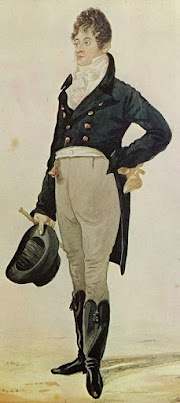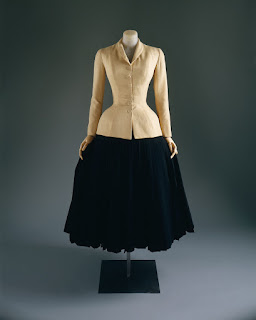18th Century Eleganza
Continuing our conversation on the importance of fashion in history, I wanted to look this week at an iconic figure that has been largely forgotten by history; George “Beau” Brummell. Not only did Brummell curate a signature look for himself, but for many of the young fashionable men that followed his lead that called themselves a Dandy. Brummell’s characteristic looks hinged on dark well-cut fabrics that remain in fashion today. Over two centuries later, a version of his sartorial influence persists in the form of a finely tailored dark suit. However, the Dandy was more than just a choice in fashion, it became a way of life where young men desired to be noticed for one’s simple attire without using grandiloquent accessories. Which contrasted the widely held belief in the late 18th century that fashion was a display of wealth. The more baubles you had, the wealthier you were.
Brummel
was born into a moderately wealthy family in 1778 in England. He attended Eton
where he made several connections to far wealthier men, chief among them was
the Prince of Wales (later George IV). With this friendship, Brummell lived as
if he were wealthy and acquired a taste for the finer things. Its hard to
overstate the importance of the Prince’s friendship to Brummell’s life. As long
as the friendship was maintained, Brummell was welcomed into every social circle
in London regardless of his middle-class status as many of his debts were forgotten
(and there were many). It was this friendship that allowed him to rise as a
style icon in London. For over a decade, Brummell reigned unchallenged as his
style was picked up by Dandies across London. During this time, he was welcomed
into the upper echelons of society as if he were a natural born member.
However, no amount of sartorial genius could have made up for his eccentric
personality. There is some contention that Brummell often put on this personality
as an extension of his clothing, as a way to get noticed. Regardless of the intent,
Brummell often got himself into trouble as he was known for loudly criticizes
his contemporaries at parties. It was likely one such critique that led to the
end of his friendship with the prince. By 1812, Brummell has fallen out of
favor with the prince and thus fallen from grace in his social circles as well.
So far,
I’ve recounted Brummell’s meteoric rise to fashion stardom, but what exactly did
his style include? Brummell took influences from various political parties in
Britain and France to create an optimum look. His trademark blue coat and buff
breeches came from the Whig party, while his high tied cravats were inspired by
trends in Post-Revolutionary France. Brummell favored a shorter style of hair
without powder inspired by the “Crops” who opposed a new tax on hair powder.
Brummell despised the heavy perfume typically used by men. Instead, he
advocated for strict attention to hygiene. Indeed, Brummell was heavily
criticized for his high standards of hygiene, which would seem normal by today’s
standards. When combined, these aspects culminated in a more natural look
reminiscent of the nudes from antiquity. In this way, the Dandy was reflective
of the neoclassical revival that was dominating the architectural community at
the same time.
Additionally, the look of a classical nude was often reflected in the tailoring as well. Tailors favored materials to mimic nudity without any real indecent exposure. Plain cloth or a sleek animal hide was a favourite as it was easily suggestive of skin. Moreover, the return to simplicity was expressed using more common materials such as wool, linen and leather. The cut of the materials emphasized the natural movement of the body while delicately hiding unwanted bulges thus creating the ideal male shape as seen in classical art.
What sets the Dandy apart from preceding men’s fashion is that is it affordable. The natural materials like wool, linen and leather were more economical than the dominating pastel silks, satins and velvets found in the Macaroni style. Indeed, men’s fashion hinged on the extravagancy of the outfit to display their great wealth as these materials were costly to procure, and the dying process was lengthy. Brummell’s style, by contrast, was achieved through the simplicity of excellent tailoring without compromising the integrity of the look with ostentatious baubles and unnecessary accoutrements.
The popularity of Dandyism in London signified a class shift; where the exclusive upper class was destabilized by the emerging middle class. In a pre-industrial economy, the aristocracy had a monopoly on wealth which was directly reflected in the amount of land they owned. As England industrialized, wealth was no longer solely reflected in land owned, but money earned. Brummell’s fashion was more affordable compared to other preceding trends which made it accessible to those in the middle class who had acquired wealth in this new economy. The anxiety over a shifting class structure was expressed in satirical representations that typically undermined the dandy as they were depicted as effeminate men obsessed with materialism rather than the more accepted manly pursuits (sports, hunting etc.).
The
persona of Brummell and the Dandies went on to inspire several literary
representations. Jane Austen was one of the many authors who took inspiration
from the Dandy in her novels. It is not explicitly stated but historians have
widely accepted that many of her male characters take on the dominant
characteristics of the dandies. They are often depicted as romantic heroes
whose special blend of morals and narcissism sets him above the common folk,
all while remaining immaculately dressed.


Comments
Post a Comment